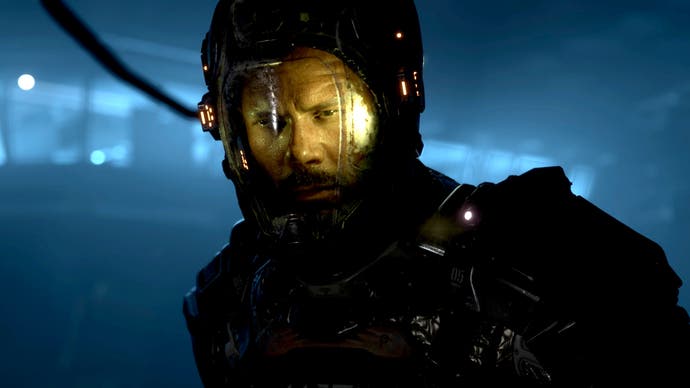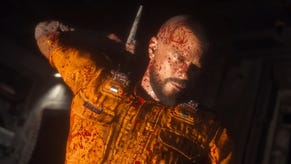The Callisto Protocol on PS4 and Xbox One - the beginning of the end for cross-gen?
A game clearly designed for new consoles works on the old... just.
The Callisto Protocol is one of the most visually advanced games currently available. With extremely high quality assets paired with multiple ray tracing effects, it packs some truly superb visuals - at least if you're playing on a high-end console or PC - but despite its remarkable graphics, The Callisto Protocol is a cross-gen title, which means it also ships on last-gen consoles, including the nine-year old base machines. So how did Striking Distance Studios manage to cram this game onto the PS4 and Xbox One? Is last-gen Callisto serviceable, or do the cuts simply run too deep? And if so, is this perhaps indicative of the beginning of the end for cross-gen development?
To put it frankly, The Callisto Protocol is seriously downgraded on last-gen consoles in a way we rarely see in cross-gen games. There's a clear generational divide, and putting the best version up against worst - PlayStation 5 vs Xbox One S - there's a vast gulf between them. The first and most obvious difference lies in texture quality. Across the board, the artwork has been hugely simplified. Texture resolution is much lower on just about any surface in the game and it's not just resolution that's been cut back - a lot of overlaid textures are simply missing.
On top of that, there's a streaming problem too: after loading a save, textures can take a while to load in fully on older hardware, sometimes taking upwards of 10 seconds before the full-res assets appear. The last-gen machines are simply way behind current-gen here, with smeared and low-detail 2D artwork. Model geometry is similarly simplified. Environments look significantly chunkier and often have a bit of a low-poly look. Broadly speaking most aspects of the game environment have less geometric complexity on the last-gen console platforms. Most of the coarse details on the walls and ground are still represented to some degree, but they have usually been decimated somewhat relative to current-gen machines. In a couple of instances, I was able to spot larger cutbacks as well - actual parts of the environments removed. Ground clutter can also see obvious cutbacks. These items don't seem to affect collision but do add some ambience that is missing on the weaker hardware.
The next major difference is a big reduction in shadow quality. The resolution of shadowmaps has been decreased in general, which is most visible on character self-shadows, which have a pared-back look relative to current-gen consoles. Certain level geometry elements no longer appear to be shadow-casting, and self-shadows are missing for a lot of the environment. Last-gen consoles have passable shadow coverage, but relative to the PS5 or Series consoles they are missing out.
Hair quality is reduced as well. Larger volumes of hair look similar across current and last-gen, but sparse hair has a very different appearance. The main character's beard looks much fuller on current-gen consoles, for example, and Sam Witwer's closely-shorn hair seems to be represented with 2D texture detail on last-gen consoles, while on PS5 and Xbox Series it has visible strands. Those are the obvious visual differences between last-gen and the current-gen versions without ray-tracing - but what if we bring in the PS5 version in its higher-quality mode, with all of its RT effects enabled?
The RT shadows make for a very obvious visual upgrade, in my opinion. Self-shadowing looks much more detailed, relative to either last-gen console or the PS5 in performance mode. Fine geometric details now cast accurate shadows even at extreme angles, shadows that would be prohibitively expensive to resolve using shadowmaps. Larger shadows showcase realistic shadow penumbra, like on this character shadow, which looks synthetic and overly sharp in shadowmap form.
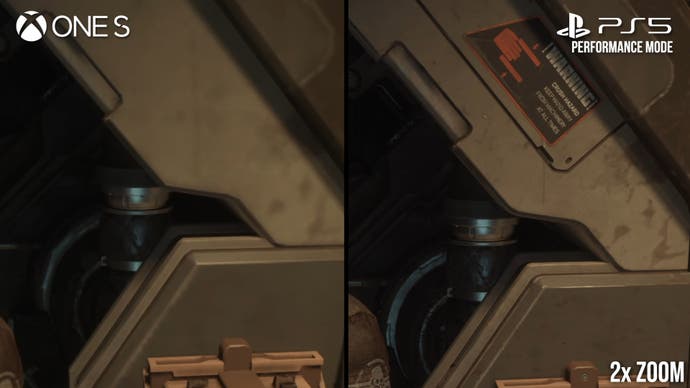

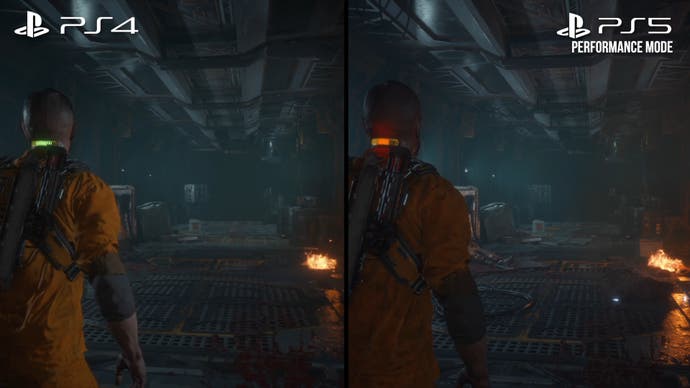

RT reflections also have a pretty major impact on the visuals. The clearest improvements come when looking at glossy surfaces parallel to the camera, where appropriate screen-space information is lacking for reasonable SSR coverage. More subtle improvements are visible on rougher, metallic materials, where the RT reflections provide more accurate colour on the PS5 version here.
Taken as a whole, the last-gen versions of The Callisto Protocol are seriously downgraded relative to current-gen machines - though the cutbacks don't really come as much of a surprise. With older GPUs and slow mechanical storage, the full-fat Callisto Protocol experience is out-of-the-question on eighth-gen hardware. That said, the final result ultimately looks pretty decent on the last-gen consoles, at least taken on its own terms. The fundamentals are still here, with strong lighting and impressive character modeling. This is still the same game, but a lot of the intricate detailing that impresses on current-gen is absent, and the advanced ray tracing effects are gone as well.
There's a clear generational divide then - and to be clear, even though it has compromises of its own, Xbox Series S clearly sits on in the same area as Series X and PlayStation 5. The visual feature set of the last-gen versions is very similar (even the extra RAM on Xbox One X doesn't result in any additional features), but the enhanced machines do receive some minor improvements. There is slightly greater shadow coverage on PS4 Pro and One X, though this only appeared on a handful of objects in my testing. Post-processing effects also improve. The per-pixel motion blur has a banded, artifact-ridden appearance on PS4 and Xbox One, but resolves more cleanly on the enhanced machines. Depth of field appears stronger and with clearer bokeh on the higher-end consoles, which is more similar to the way depth of field resolves on PS5. The higher rendering resolution on PS4 Pro and One X may be the culprit here, producing more refined post-processing in line with the increase in pixel count.

Ultimately, and perhaps unsurprisingly, the biggest difference between the last-gen machines lies in rendering resolution. Unfortunately, Callisto is a tough game to pixel count for a variety of reasons - most notably because the motion blur setting seems to be bugged on last-gen consoles and can't be turned off at the moment - and we do have a lot of platforms to cover. So these pixel counts aren't exhaustive, but should be indicative of the resolutions you can expect in typical play.
Xbox One S is the console that exhibits the most variability. I counted results as low as 720p and as high as 900p, though again it's possible it could vary further, and it seems to spend a lot of time around 800p-900p or so. PS4 counts in at 1080p at highest and seems to operate at 1080p most of the time as well, though it can dip somewhat under load. One X and PS4 Pro are more curious. Both consoles essentially deliver a stable 1440p resolution - I noticed a tiny bit of deviation on PS4 Pro, but One X seemed totally locked. Typically we would expect a substantial resolution advantage for the One X but all indications are that both consoles deliver the same pixel count here.
So visual settings are reasonable, though comprehensively downgraded compared to current-gen, and image quality is pretty good for the most part. But how does performance fare? This is where the last-gen systems are truly taxed, unfortunately. First though, we should get something out of the way - the cutscenes. Unsurprisingly, The Callisto Protocol targets 30fps on last-gen consoles, but that isn't the initial impression you get from starting the game. After the opening pre-encoded cutscene, the real-time sequence that follows runs at roughly 24fps across all last-gen consoles. It clearly stutters and has an odd frame cadence of alternating 33ms and 50ms frames. This holds true for all the real-time cutscenes in the game that I encountered. All of them run at about 24fps, with occasional frame-time spikes and stutters, but never really getting anywhere near 30. This applies to shorter cutscene sequences as well, like when checking this container near the start of the game, or when the player opens certain doors. This cap seems to be intentional and likely allows for higher image quality via dynamic resolution scaling - a trick also used in The Matrix Awakens.
In gameplay, Xbox One S - the weakest of the consoles we're testing - does a pretty poor job of hitting its 30fps target in typical play. Many of the game's environments cause sustained frame-rate drops, and results in the mid-20s are common - very cinematic perhaps, but not especially good for input response or animation. Combat can cause further frame-rate issues, with results in the low-to-mid 20s proving quite typical for encounters with multiple foes. To be fair, the One S can hit 30fps in more sedate areas when out of combat. But it's usually below 30fps and often well below. The PS4, in contrast, is a much stronger performer. It can still drop hard if pushed during select sequences, but it manages to hold 30fps much more often. When the One S is buckling in the 20-25fps region, the PS4 often manages to stick to 30fps with the occasional dropped frame. That said, there are still stutters but at least PS4 delivers generally serviceable performance.
The PS4 Pro is a slightly stronger performer than the PS4. Again, we do see dropped frames somewhat frequently, though it's hard to get the game to dip below the high twenties. Generally it's a 30fps experience with small dips and of course those 24fps cutscenes as well. Xbox One X actually manages to hit and hold 30fps in gameplay pretty consistently. The one-off frame drops still occur, though only occasionally, and sometimes there are some larger stutters during traversal, but outside of cutscenes the frame-rate is reasonably stable. Perhaps the relatively conservative resolution target is helping here.
I wouldn't say The Callisto Protocol performs especially well on last-gen consoles. The PS4 and Pro versions are serviceable enough, with significant but not game-breaking drops, and the One X does manage a pretty stable 30fps during gameplay. However, the cutscenes are juddery and off-putting, and substantial performance issues pop-up with enough frequency to make the game feel somewhat inconsistent. Considering the frame-rate issues that crop up even on current-gen consoles though, this is a decent showing for the weaker last-gen console hardware. The performance woes on Xbox One S are harder to excuse, with severe and frequent frame-rate drops. Perhaps the resolution figures need a further haircut, or visual features could be pared-back further, but in any case performance needs to be improved.
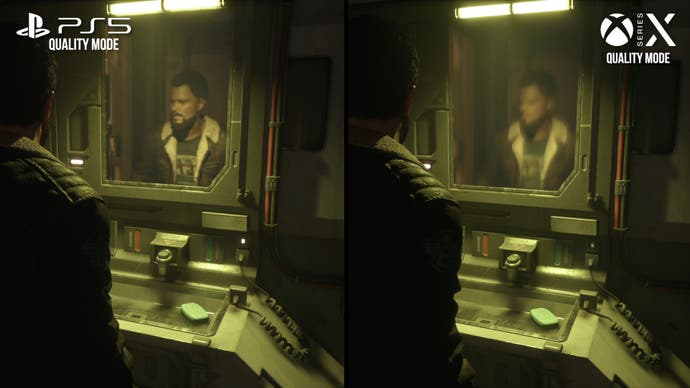
The Callisto Protocol was never going to be a typical modern cross-gen game, It's not a title that features similar visuals across all platforms, nor are there reasonable performance metrics across a broad range of console hardware. Instead, visuals are comprehensively pared-back on last-gen consoles and performance runs the gamut from decent to poor, with the One S in particularly questionable form.
Despite its cross-gen heritage, The Callisto Protocol is a game that seems squarely targeted at current-gen hardware, and is definitely best enjoyed on newer consoles. Even the Series S version looks and performs much better than the One X release, which is the strongest of the last-gen versions. Callisto is a stark reminder of the hardware advantages inherent to current-gen tech. That said, the PS4, PS4 Pro, and One X do offer a decent enough experience, judged in isolation. The unfortunate exception is the Xbox One release, which is best avoided for now.
There is still the sense that cross-gen is on its last legs here, though, and we're cool with that. To its credit, Striking Distance has delivered a multi-platform project that does leverage the capabilities of the new consoles extensively to the point where initially we couldn't quite envisage how the developer would scale the game down to last-gen machines but somehow they've done it. Judged on their own terms and outside of comparison head-to-heads, all versions bar base Xbox One work - but there's still often the sense that the hardware is being pushed too far, that the core design of the game is no longer a good fit for the capabilities of the older machines. Put into context, the results here are nowhere near as bad as some of the PS4 ports we saw on PS3, but I do feel that we've reached the limit here - and The Callisto Protocol is indeed perhaps the beginning of the end of this massively extended cross-gen transition.
